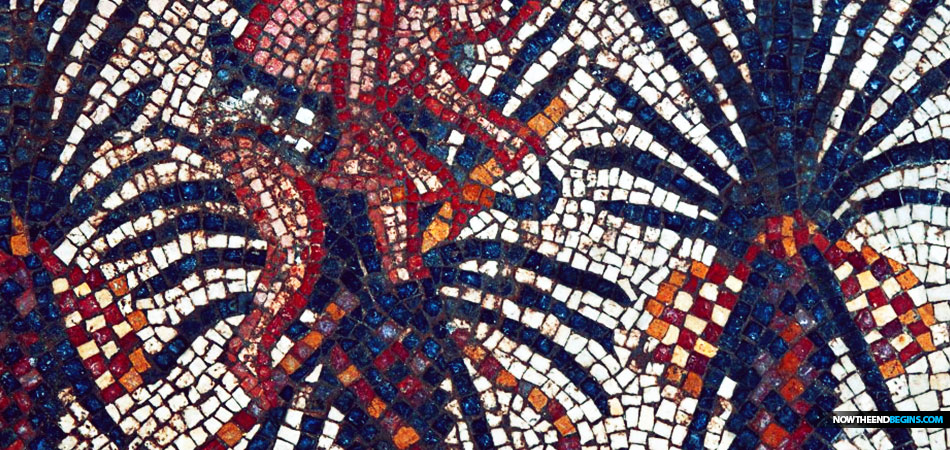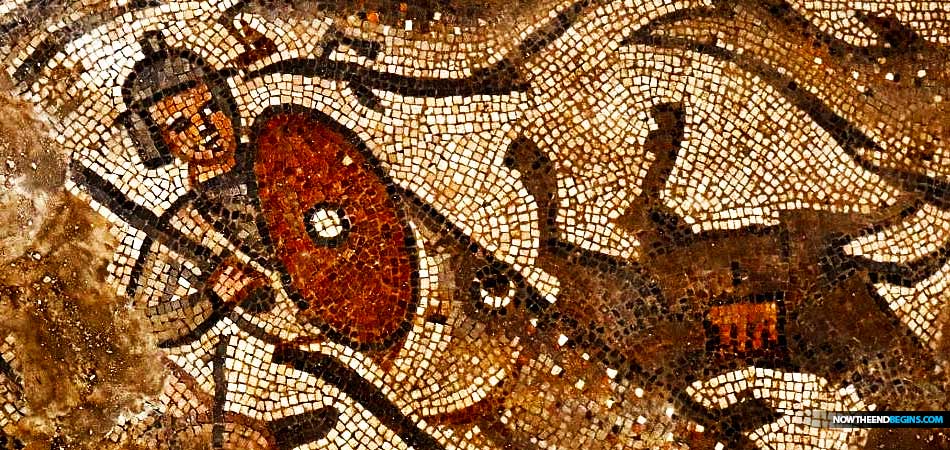
Biblical archaeologists in Huqoq have uncovered a stunning 1,600-year-old biblical mosaic in northern Israel depicting four beasts described in Chapter 7 of the Book of Daniel. The beasts represented four kingdoms preceding the end of days.
New archaeological discoveries are coming to the surface on nearly a monthly basis now, a veritable flood of artifacts confirming not only the history of the Jewish people in the land of Israel, but shedding new light on Bible prophecy as well. This latest find in Huqoq has to do with both the Exodus of the Jews, and the 4 Beasts of the end times we read about in Daniel 7.
"Daniel spake and said, I saw in my vision by night, and, behold, the four winds of the heaven strove upon the great sea. And four great beasts came up from the sea, diverse one from another. The first was like a lion, and had eagle's wings: I beheld till the wings thereof were plucked, and it was lifted up from the earth, and made stand upon the feet as a man, and a man's heart was given to it. I beheld till the thrones were cast down, and the Ancient of days did sit, whose garment was white as snow, and the hair of his head like the pure wool: his throne was likethe fiery flame, and his wheels as burning fire. A fiery stream issued and came forth from before him: thousand thousands ministered unto him, and ten thousand times ten thousand stood before him: the judgment was set, and the books were opened." Daniel 7:2-4,9,10 (KJV)
I find it so amazing that as these long-buried
archaeological treasures are coming to light, that the human race stands on the very precipice of watching the prophecies they reference about to come true in stunning fashion.
I was not able to locate a picture of the Daniel mosaic the article references, but had a great phone call with Carly from
University of North Carolina, the team that found the mosaics and she said she would forward that to me as soon as it becomes available.
1,600-year-old biblical mosaic discovered in Israel sheds light on Bible prophecy and revelation
FROM FOX NEWS: The mosaic, which depicts a scene from the book of Exodus, was found at the site of a fifth-century synagogue in Huqoq. Excavation director Jodi Magness, a professor at University of North Carolina at Chapel Hill, said the mosaic was the first depiction of the episode of Elim from Exodus 15:27 ever found in ancient Jewish art. “Elim is where the Israelites camped after leaving Egypt and wandering in the wilderness without water,” she explained in a
statement, noting that the mosaic is separated into three registers or horizontal strips.
One register showed clusters of dates being harvested by
loincloth-clad agricultural workers while another showed a row of wells and date palms, she explained. “On the left side of the panel, a man in a short tunic is carrying a water jar and entering the arched gate of a city flanked by crenellated towers. An inscription above the gate reads, ‘And they came to Elim’,” Magness added.
Chapter 7 in the book of Daniel describes four beasts which represent the four kingdoms leading up to the end of days. This year
our team discovered mosaicsin the synagogue’s north aisle depicting these four beasts, as indicated by a fragmentary Aramaic inscription referring to the first beast: a lion with eagle’s wings. The lion itself is not preserved, nor is the third beast. However, the second beast from Daniel 7:4 – a bear with three ribs protruding from its mouth – is preserved. So is most of the fourth beast, which is described in Daniel 7:7 as having iron teeth.
Archaeologists also discovered mosaics depicting four beasts described in Chapter 7 of the Book of Daniel. The beasts represented four kingdoms preceding the end of days.
“The Daniel panel is interesting because it points to eschatological, or end of day, expectations among this congregation,” said Magness, in the statement. “The Elim panel is interesting as it is generally considered a fairly minor episode in the Israelites’ desert wanderings – which raises the question of why it was significant to this Jewish congregation in Lower Galilee.”

A fish swallows an Egyptian soldier in a mosaic scene depicting the splitting of the Red Sea from the Exodus story, from the fifth-century synagogue at Huqoq, in northern Israel.
The excavation marked the ninth year of digs at the Huqoq site. The first mosaics were discovered in 2012. Between 2014 and 2017, archaeologists discovered mosaics depicting Noah’s Ark, the parting of the Red Sea, Jonah and the fish and the Tower of Babel, painting a fascinating picture of life at the ancient site.
In 2018 researchers also announced the
discovery of a stunning mosaic depicting a biblical scene from Numbers 13:23. Labeled "a pole between two," the panel showed two spies sent by Moses to explore the biblical land of Canaan.
Another mosaic discovered at Huqoq includes a depiction of Samson. There also has been an ongoing debate about whether a mosaic uncovered in 2016 portrays Alexander the Great. The purported Alexander the Great mosaic was the first non-biblical story ever found decorating an ancient synagogue.
READ MORE
Carolina Researchers Continue to Discover Ancient Mosaics in Israel
Recent discoveries by a team of specialists and students at Huqoq in Israel’s Galilee, led by University of North Carolina at Chapel Hill professor Jodi Magness, shed new light on the life and culture of an ancient Jewish village. The discoveries indicate villagers flourished under early fifth century Christian rule, contradicting a widespread view that Jewish settlement in the region declined during that period. The large size and elaborate interior decoration of the Huqoq synagogue point to an unexpected level of prosperity.
No comments:
Post a Comment